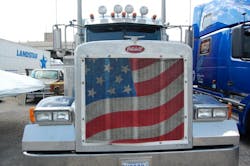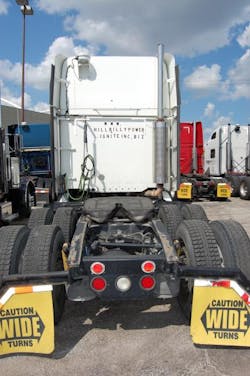I’m kicking myself this morning because I couldn't dial in and listen to a presentation yesterday by Todd Spencer, executive VP for the Owner-Operator Independent Driver Association (OOIDA); a presentation hosted by Wall Street investment firm Stifel Nicolaus.
Stifel’s John Larkin characterized Spencer’s presentation as “spirited,” which is a MAJOR understatement if anyone has ever listed to Spencer speak when he’s “fired up” over a particular issue such as hours of service (HOS) reform.
[The clip below, featuring Spencer at a “listening session” two years ago commenting on proposed HOS changes, gives you an idea of what I mean.]
Stifel invited Spencer to provide some owner-operator perspective on the huge number of trucking regulatory changes – past, present and pending – promulgated by the federal government.
It’s Spencer’s belief – one I suspect shared by many in the industry, and not just by independents – that these are often “well-meaning” efforts that all-too-often end up becoming major impediments to the safe and efficient operation of trucking-based supply chains in the U.S.
Here are but some of the points Spencer touched on:
Recent surveys of OOIDA’s membership indicate that fewer small carriers are optimistic about freight rates rising in 2013: Only 16% of respondents believe that freight rates will rise in 2013. That compares to the 24%, who responded to a similar survey taken about two years ago, who thought that freight rates would increase in 2011. Some 41% of those responding to the survey thought that rates would actually decline in 2013 while 44% expected freight rates to remain unchanged in 2013. In the survey taken in early 2011, a full 57% of those carriers responding expected freight rates to rise in 2011.“The deterioration in freight rate expectations this year supports our view that freight market demand remains mediocre at best,” noted Stifel’s Larkin.
Compliance, Safety, Accountability (i.e., CSA) remains a work in progress: Despite numerous studies suggesting that CSA scores are not highly correlated with crash frequency or severity, the Federal Motor Carrier Safety Administration (FMCSA) continues to push ahead with the program, said Spencer. As a result, some shippers and brokers – in the interest of managing their potential liability – feel as though they must avoid carriers with CSA basic scores that fall above the “threshold,” whether or not those scores accurately reflect their true safety status.
To make matters worse, said Spencer, only those carriers with a sufficient number of violations and inspections qualify for CSA scores, he stressed. Smaller carriers without sufficient numbers of violations and inspections simply are not rated under the current system with respect to their safety ratings. And, since some shippers and brokers do not know if the un-rated carrier is safe or not, they tend to err on the side of conservatism by simply steering clear of those carriers without any CSA score at all.
Carriers with speed limiters and electronic on-board recorders generally are not any safer than those carriers without those devices installed. The factor that matters most with respect to accident frequency and severity appears to be experience, said Spencer. A driver with 20 years of experience is less likely to have an accident than say a driver that has just six months of driving experience. Furthermore, owner-operators and independent drivers not only have more experience than the average company truck driver, but they also tend to make better decisions given their relatively higher level of business acumen and the fact that they own their own truck.The new HOS rules may reduce productivity of the industry by 5% to 10%. While the intentions of the new rules (which go into effect on July 1) are “valiant,” in Spencer’s words, most truckers believe that rules eliminate some of the flexibility drivers need to respond to what their brains and bodies are telling them. The new 34-hour restart provision is the most troubling as it requires that driver’s weekly schedules be reset once a week – and each resetting must include two consecutive nights of sleep each inclusive of the hours from 1 a.m. through 5 a.m. within the context of the relevant time-zone at their home terminal.
That means, said Spencer, that West Coast domiciled drivers cannot start out after their weekly rest while on the East Coast until 8 a.m. eastern standard time. Thus, they are prevented from getting a jump on the rush hour. In addition it is not clear – by any means – that HOS violations are a good predictor of crashes anyway, he added.
The Environmental Protection Agency (EPA) continues to wreak havoc on the trucking industry. Over the past ten years, Spencer said OOIDA estimates that $30,000 has been added to the cost of a new truck as a result of increasingly tough federally-mandated emissions regulations. As a result, only 20% of owner-operators and independent drivers are able to buy a new truck as a replacement for the old truck. Instead, 80% buy later model used trucks in an effort to keep their truck life cycle costs at a minimum.
The National Registry of Medical Examiners will require that medical examiners wishing to certify the fitness of a truck driver must ultimately follow a specific procedure at a minimum. The procedure will likely mandate body mass index (BMI) testing to determine which drivers are candidates for sleep apnea testing. Given that sleep apnea testing can cost upwards of $3,000 to $5,000 and 71% of drivers or potential drivers do not carry medical insurance that covers testing of this type, Spencer said OOIDA expects that many will opt out of the industry totally. He also speculated that between 10% and 15% of the current driver population could exit the industry as a result of the focus on sleep apnea alone. Other testing procedures for other potentially debilitating ailments could add insult to injury and contribute to a severe driver shortage at some point in the future.
The recently enacted Highway Bill (MAP-21) contains a provision that will likely result in increased liability coverage for all carriers. Currently the minimum coverage is $750,000. A substantial increase in the required coverage will disproportionately increase the cost of coverage for smaller carriers as they are unable to self-insure for any of their layers of insurance coverage. Spencer argued that higher levels of liability insurance coverage will not increase carrier’s focus on safety, but rather would simply increase the operating cost of the already cost disadvantaged small carriers, independent drivers, and owner-operators.
Safety and fuel efficiency are now often at cross purposes. With different federal agencies focusing on fuel efficiency and safety, OOIDA is witnessing obvious – and more frequent – conflicts, for what is fuel efficient (such as high pressure tires with minimal tread depth) is not always safe. And there appears to be no efficient mechanism within the massive federal bureaucracy to mediate these obvious conflicts, warned Spencer.
Well, that’s a laundry list of trouble, ain’t it – and in many respects it’s just the tip of the iceberg where trucking is concerned.
Yet can the industry – and especially the smaller players within it – cope with all of those issues successfully and still move freight efficiently, all while making a profit? That’s the million-dollar question, isn’t it?


